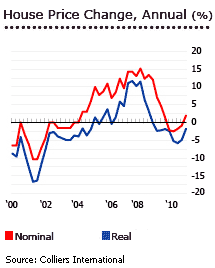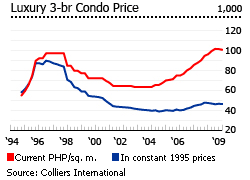Price rises resume in the Philippine housing market

The residential real estate market in the Philippines is back on track, with a strong economic recovery, and a wave of optimism.
Average prices of luxury-3 bedroom condominiums in Makati CBD, the financial capital, rose 1.5% q-o-q to PHP101,600 (US$2,300) per sq. m. in Q3 2010, the second quarterly increase after a 0.9% increase in Q2, according to Colliers International. The average price was up by 1.9% from a year earlier, but down by 1.8% when adjusted for inflation.
The Philippine economy expanded by 7.3% in 2010. Election-related spending pushed growth in the first-half, and remittance-supported household spending and rising exports and investments sustained the growth in the second half.
Real estate prices are expected to rise by 3% to 5% in 2011, according to Colliers International. Makati CBD is expected to lead the way with a 5.4% y-o-y increase, while prices in other key areas of Metro Manila (Rockwell Center and Bonifacio Global City) are expected to rise by 3%.
The housing market relies heavily on remittances from overseas Filipinos, especially subdivisions and other housing projects in provinces near Metro Manila. Condominium demand in Metro Manila, on the other hand, is pushed by employees in the rapidly expanding business-process outsourcing (BPO) industry (primarily call centre agents).
The number of condominium units in five key central business districts of Metro Manila increased by around 3,900 units in 2010, bringing the total stock to around 40,000 units, according to Colliers. The rate of completions is expected to accelerate in 2011, with new supply seen to be around 8,958.
The growth of the housing market would have been much faster if not for several factors. Most house purchases are done either in cash or through pre-selling, as the financial market is relatively undeveloped. Property buyers also face high transaction costs, corruption and red tape, fake land titles and substandard building practices.
The implementation of the much-anticipated Real Estate Investment Trust (REIT), expected to increase market liquidity, is being hindered by regulatory, tax and other issues, although the implementing rules and regulations became law more than a year ago, in December 2009.
Economic growth is expected to moderate in 2011 to 5%-6%. Inflationary pressures remain relatively weak with consumer prices expected to rise by around 3% to 4% in 2011, at par with the 3.8% inflation in 2010 and 3.2% in 2009.
Memories of Asian Crisis

Luxury condo prices rose by an average of 9.3% both in 2005 and 2006, 14% in 2007 and 11.3% in 2008. However in real terms, average prices rose by 1.6% in 2005, 2.9% in 2006, and 1.9% in 2008. Only in one year, 2007, did real prices rise by more than 10%, at 11.3%.
During the Asian Crisis, Philippine luxury condominium prices dropped 18% (25.3% in real terms) from 1997 to 1998. Between 1997 and 2004, luxury condominium prices dropped 34.4% (56.2% in real terms). The Philippines experienced the biggest property price fall among the economies affected by the 1997 Asian Financial Crisis.
A speculative bubble had formed in the 1990s after financial liberalization and economic reforms attracted capital inflows. Luxury condominium prices rose 63% (46% in real terms) between 1995 and 1997.
More recently, demand for office space for information and communications technology (ICT) related firms such as call centers and other business process outsourcing (BPO) firms has been behind the real estate sector revival. The new employees boosted the demand for rental housing, with a ripple effect on the construction, retail, and telecommunications sectors.
As a result, property prices increased 59.3% (16.2% in real terms) from 2005 to 2008. In Q1 2009, nominal prices were above 1997 levels, but real prices were still 48% below pre-Asian crisis peak levels.
Lower overseas demand
The share of sales to Overseas Filipinos (OF) by Ayala Land shrank to 24% in 2008, down from 32% in 2007, and 37% in 2006.
There are approximately 9 million Overseas Filipinos (OF) worldwide, or around 10% of the Philippine population. Of all OFs, 42.3% are permanent.
Among permanent OFs, 68.2% reside in the US, followed by Canada (11.1%), Europe (7.7%), Australia (6%), and Japan (3.6%). The economies of these countries are in deep recession.
Saudi Arabia has the most OFWs, at 25.3% of the total, and followed by UAE (11.9%). Housing demand from OFWs in the Middle East is expected to weaken, because the economies of the major OFW employers, Saudi Arabia, UAE, and Kuwait, have weakened.
Remittance growth will weaken

Remittances from OFs are major drivers of consumption and investment in the Philippines. Remittances reached US$16.4 billion in 2008, around 9.7% of GDP. A significant portion of remittances is spent on housing.
Although remittances grew 2.7% y-o-y to Q1 2009, total remittances in 2009 are expected only to match 2008 levels, in sharp contrast to double-digit growth rates in the past. In 2008, remittances rose 13.7%, following 13.2% growth in 2007, 19.4% in 2006 and 25% in 2005.
Even if remittances continue growing in 2009, purchases of residential property may be delayed, until the economy recovers.
The mortgage market is small
In the Philippines, most buyers pay in cash, or buy during the pre-sale period. With remittance-fed demand weakening, local demand is hampered by an underdeveloped mortgage system.
The ratio of housing loans to GDP remains small, at less than 2%. Outstanding real estate loans for acquisition of residential property grew by an average of 14% annually from 2001 to 2007, to PHP112.2 (US$2.4) billion. Data for 2008 is still unavailable but growth is expected to exceed 10%, because the BSP relaxed rules on real estate lending in December 2007 to support the property industry.
Despite this growth, several factors still hamper local mortgage market expansion. Banks impose restrictive lending conditions, and approval of loan applications takes a long time. Few major banks offer housing loans, and loans have similar terms and conditions. Land titling and registration problems are prevalent, as are delays in the foreclosure process.
Housing loan rates charged by major commercial banks remain high, at around 9.5% for loans fixed for one year, and at least 11% for mortgages with rates fixed for five years or more. In-house financing offered by developers involves even higher rates of between 15% and 22%.
The government-owned Pag-ibig Fund (Home Development Mutual Fund) offers lower interest rates of between 6% to 11.5%, depending on the amount borrowed and loan conditions. Compared to bank loans, the amount that can be borrowed is lower, but the payment periods are longer and loan-to-value ratios are higher. Membership requirements have to be fulfilled to get a loan.
Rental yields are high
In October 2008, the average rental yield for condominiums in CBDs in Metro Manila was around 9.4%, according to Global Property Guide research. The highest returns were achieved on condominiums measuring between 70 and 120 sq. m., with yields typically exceeding 10%. Rental yields are expected to remain high, as property prices are expected to fall faster than rents.
The average rent for luxury three-bedroom condominiums in the Makati CBD fell by 1.4% (-1.2% in real terms) in Q1 2009 from the previous quarter, to PHP576 per sq. m.
Compared to a year earlier, the average rent rose by 5.1% in Q1 2009. However, when adjusted for inflation, the average rent declined by 1.7% during the same period.
Rents in the Makati CBD peaked in the second half of 2008, at an average rent of PHP584 per sq. m., according to Colliers International.
Rents in Rockwell and Bonifacio Global City remain at PHP684 per sq. m. and PHP625 per sq. m., respectively. However, rents in these areas are expected to drop in 2009 due to the deteriorating economic situation.
Oversupply continues
Residential construction starts in the Philippines peaked in 2005. Construction starts then fell by 16.8% in 2006, and by 13.1% in 2007. Condominium construction declined the most, falling by 29.6% in 2006 and 43% in 2007, according to a study by Jun Sanchez of PinoyDreamHouseToday. Although construction starts rose 8.3% in 2008, they remained 22% below the 2005 level.
There seems to be an oversupply of condominiums in Metro Manila. Colliers International reports that Makati vacancy rates rose to 9% in Q1 2009, up from 8.4% a year earlier. Yet around 48% of constructed condominiums between 2004 and 2008 were in CALABARZON, a fast-growing region just beside Metro Manila. Metro Manila region only had the fourth most constructed residential properties, among the eight regions. From 2004 to 2008, 17% of the total condo newbuilds were in Metro Manila. On the other hand, 11% of total single house constructions were in Metro Manila.
Completions of dwellings started one to two years ago are expected to add to the oversupply. In Metro Manila, around 4,200 residential units are expected to come to completion in 2009, while around 5,400 more completed units are expected in 2010.
Brink of recession

There was a measly 0.4% GDP growth in the year to Q1 2009, according to the National Statistical Coordination Board (NSCB). However, seasonally adjusted GDP figures show a contraction of 2.3%, the worst in 20 years.
The government expects GDP to grow by 0.8 to 1.8% in 2009. The IMF is more pessimistic, forecasting an economic contraction of 1% in 2009, and flat growth in 2010.
The Philippines’ unemployment rate is the second-highest rate in the ASEAN region, despite improving to 7.5% from the previous quarter.
By May, inflation had slowed to a 22-year low of 1.5%. The BSP forecasts inflation to be between 2.5 and 4.5% for 2009. The BSP already reduced the overnight borrowing rate in May 2009 to 4.25%, the lowest for 17 years. Further reduction of rates this year may happen, as the economy continues to deteriorate.